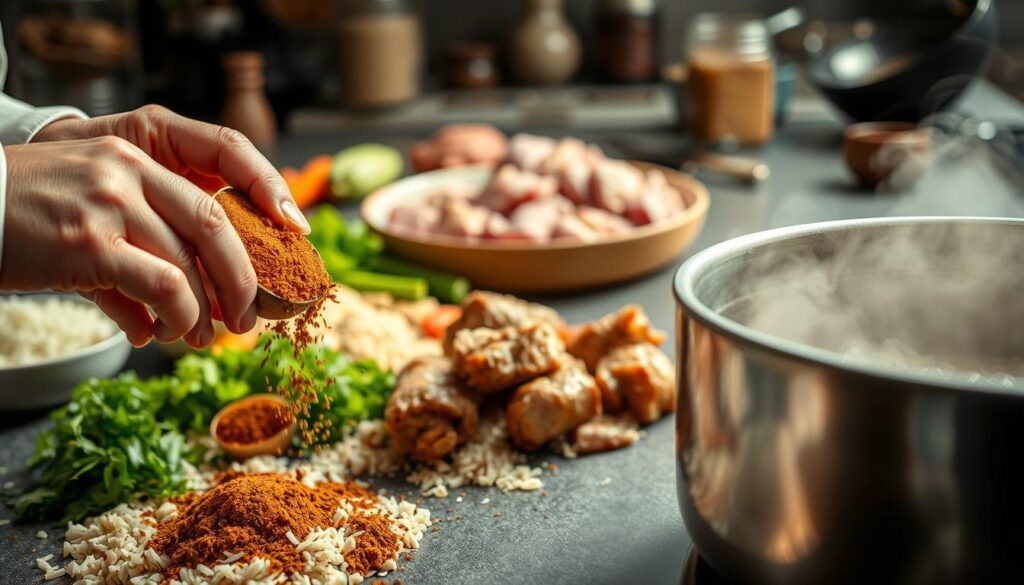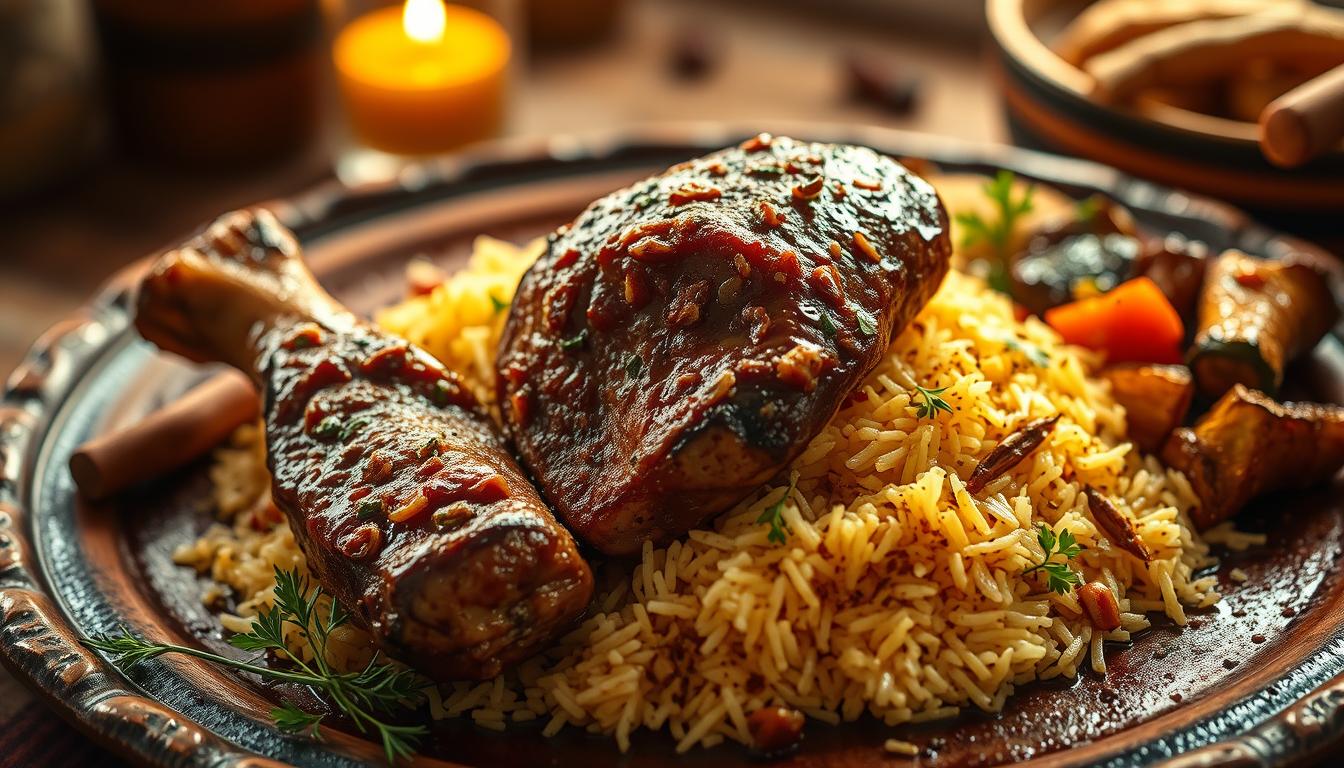Authentic Saudi Kabsa Recipe with Meat
Imagine a dish that embodies the rich culinary heritage of the Arabian Peninsula, a flavorful blend of meat, rice, and spices that has become a staple in Middle Eastern cuisine.
Saudi Kabsa Recipe with Meat, is more than just a meal; it’s a reflection of the region’s history and traditions. This iconic rice and meat combination is infused with a distinct flavor profile, thanks to the perfect balance of aromatic spices.
As you explore the world of Kabsa, you’ll discover the significance of this beloved dish and how it brings people together. With its wholesome and comforting taste, it’s no wonder Kabsa remains a favorite throughout the Middle East.
Key Takeaways
- Learn the secrets of creating an authentic Saudi Kabsa with meat and rice.
- Understand the cultural significance of Kabsa in Saudi Arabian cuisine.
- Discover the perfect blend of spices that give Kabsa its unique flavor.
- Master the techniques for cooking rice and meat to perfection.
- Explore the versatility of Kabsa with different types of meat.
What is Saudi Kabsa?
In the heart of Middle Eastern cuisine lies Saudi Kabsa, a dish that embodies the region’s hospitality and generosity. This traditional dish is a staple in Saudi Arabia and is often served on special occasions.
The National Dish of Saudi Arabia
Saudi Kabsa is considered the national dish of Saudi Arabia, where rice is a fundamental component. It is typically made with meat and a variety of spices, reflecting the rich culinary heritage of the region.
Cultural Significance and Traditions
In Gulf Arab countries, Kabsa is more than just a meal; it symbolizes hospitality, generosity, and community. The tradition of serving Kabsa on large communal platters highlights the importance of shared dining experiences.
| Cultural Aspect | Significance |
|---|---|
| Hospitality | Reflects the generous nature of the hosts |
| Community | Strengthens social bonds among family and friends |
| Tradition | Preserves culinary heritage through generations |
History and Origin of Kabsa
The story of Kabsa is one of cultural exchange and culinary evolution. As a beloved dish in Saudi Arabia and beyond, Kabsa’s history reflects the rich cultural heritage of the Middle Eastern region. This flavorful meal, centered around aromatic rice and tender meat, has become an integral part of the culinary landscape.
Etymology of the Word “Kabsa”
The etymology of the word “Kabsa” is not well-documented, but it is believed to have origins in the Arabic language. The term “Kabsa” might be related to the way the ingredients are mixed together, reflecting the culinary technique used in preparing this iconic meal.
Regional Variations Across the Middle East
Throughout the Middle East, variations of Kabsa reflect local preferences and cultural influences. For instance, in Kuwait, a similar dish called Majboos features distinct spice combinations, while Yemen’s Mandi employs different cooking techniques. These regional variations demonstrate how a single dish can evolve across geographical boundaries while preserving its essential character.
Essential Ingredients for Authentic Kabsa
To make authentic Saudi Kabsa, you’ll need to understand the essential ingredients that give this dish its characteristic flavor. The right ingredients are crucial for creating a delicious and authentic Kabsa.
Meat Options: Beef, Lamb, and Chicken
You can make Kabsa with various types of meat, including beef, lamb, and chicken. The choice of meat depends on personal preference and regional traditions. Beef is commonly used in Saudi cuisine, while lamb adds a richer flavor. Chicken is a leaner option and is often used in modern variations.
Rice Selection and Preparation
The type of rice used in Kabsa is typically long-grain rice, which is preferred for its fluffy texture and ability to absorb flavors. Proper preparation of the rice is crucial, involving rinsing and soaking before cooking to achieve the perfect consistency.
Kabsa Spice Blend Components
The distinctive Kabsa spice blend is a mix of cardamom, cinnamon, cloves, black pepper, cumin, coriander, and bay leaves. This blend is the heart of Kabsa, providing its characteristic flavor. Key components include:
- Dried black lime (loomi) for a tangy note
- A combination of spices that are added at different stages of cooking
- The option to use pre-made Kabsa spice blends or create your own mix

Kitchen Equipment You’ll Need
Preparing an authentic Saudi Kabsa recipe requires more than just the right ingredients; it demands the appropriate kitchen equipment. The choice between traditional and modern cooking methods significantly impacts the final result.
Traditional vs. Modern Cooking Methods
Traditional cooking methods for Kabsa involve using a heavy-bottomed pot or Dutch oven on the stovetop, allowing for a gradual development of flavors. In contrast, modern methods utilize a pressure cooker to significantly reduce cooking time while intensifying the flavors.
Pressure Cooker vs. Stovetop Options
When deciding between a pressure cooker and stovetop, consider the trade-offs. A pressure cooker can cook beef to tender perfection in 35-40 minutes, whereas stovetop cooking requires 1.5-2 hours. While the pressure cooker method forces spices and aromatics into the meat under heat and pressure, stovetop cooking allows for greater control and traditional layering techniques in a pan.
| Cooking Method | Cooking Time | Flavor Development |
|---|---|---|
| Pressure Cooker | 35-40 minutes | Intensified flavors |
| Stovetop | 1.5-2 hours | Gradual flavor development |
To caramelize onions, use a separate pan over medium heat, stirring occasionally until they reach the desired level of browning. This step enhances the overall flavor profile of your Kabsa.
How to Make Saudi Kabsa Recipe with Meat
Preparing Saudi Kabsa with meat is a multi-step process that requires some patience, but the end result is delicious. To start, you’ll need to prepare the meat, create an aromatic base, and then cook the rice to perfection.
Preparing the Meat
Begin by cooking your chosen meat (beef, lamb, or chicken) in a large pot with some oil until it’s browned. Keep occasionally stirring to prevent the meat from burning or sticking to the pan. This step is crucial for developing the rich flavors of the Kabsa.
Creating the Aromatic Base
Once the meat is cooked, you’ll need to create the aromatic base by adding spices and other ingredients to the pot. This mixture will form the foundation of the dish’s flavor profile. The combination of spices and herbs is what gives Kabsa its unique taste.
Cooking the Rice to Perfection
Rinse and wash the rice until the water runs clear, then soak it in lukewarm water for 20 minutes. After soaking, drain the rice and add it to the pot with the cooked meat and aromatic base. Mix well and let it come to a boil. Season as needed, then reduce the heat to low, add butter, and cover the pan. Let it cook for 17 minutes more. To achieve perfect Kabsa, the rice should be fluffy with separate grains, infused with the complex flavors of the spices and meat broth.
Some key tips for cooking Kabsa include using properly prepared basmati rice, maintaining the correct rice-to-liquid ratio, and not disturbing the rice while it cooks. By following these steps, you’ll be able to create an authentic Saudi Kabsa dish that’s sure to impress.
Step-by-Step Cooking Process
In this section, we will walk you through the step-by-step process of cooking Saudi Kabsa with meat. This traditional dish requires attention to detail and the right techniques to achieve the perfect balance of flavors.
Phase1: Cooking the Meat
Start by cooking the beef in a large pot over medium heat. Keep occasionally stirring to prevent the meat from burning or sticking to the pan. When the tomato sauce reduces and the meat is cooked, pour two and a half cups of boiling water into the pot. This step is crucial as it creates the flavorful broth that will cook the rice.
Phase2: Preparing the Rice and Spices
Rinse and wash the rice, then let it soak in lukewarm water for 20 minutes. Drain the rice and add it to the pot with the meat and sauce. Mix well, ensuring that the rice is coated with the aromatic liquid without breaking the rice or crushing the garlic.
Phase3: Combining and Final Cooking
Bring the mixture to a full boil over medium heat, then immediately reduce to the lowest possible setting and cover tightly with a lid. Allow the rice to steam undisturbed for exactly 17 minutes. After the cooking time is complete, remove from heat but keep covered for an additional 5 minutes. Then, gently fluff the rice with a fork.
| Cooking Phase | Action | Time |
|---|---|---|
| Phase1 | Cook the beef | Until tender |
| Phase2 | Prepare rice and spices | 20 minutes soaking |
| Phase3 | Combine and cook | 17 minutes |

Kabsa Variations to Try
You can experiment with different types of Kabsa to find the one that suits your culinary preferences. The traditional Saudi Kabsa recipe is a flavorful dish that can be adapted in various ways.
Chicken Kabsa
For a lighter version, you can make Chicken Kabsa using marinated chicken cooked with aromatic spices and served with fragrant rice.
Lamb Kabsa
Lamb Kabsa is another popular variation, where tender lamb is slow-cooked with a blend of spices, resulting in a rich and savory beef-free alternative.
Vegetarian Adaptations
Vegetarian Kabsa is a great option for those who prefer a meatless meal. This variation is made with a variety of vegetables such as potatoes, carrots, and peas, and can be enhanced with protein-rich ingredients like chickpeas or tofu, making it a satisfying and filling beef alternative.
Traditional Garnishes and Accompaniments
When serving Kabsa, the right garnishes and accompaniments can make all the difference. Traditional elements not only enhance the dish’s visual appeal but also contribute to its overall flavor profile.
Nuts and Raisins
Nuts and raisins are classic garnishes for Kabsa, adding texture and a touch of sweetness. You can use almonds, pine nuts, or walnuts, toasted to bring out their natural oils and enhance their flavor.
Yogurt and Sauce Pairings
Serving Kabsa with a side of yogurt or a tangy sauce can help balance its rich flavors. Consider a cucumber yogurt sauce or a spicy tomato sauce to add a cooling contrast.
Fresh Herbs and Citrus
Fresh herbs like parsley, cilantro, and mint add a bright, fresh flavor to Kabsa. You can also serve the dish with wedges of lemon or lime, allowing diners to add a burst of citrus acidity. The combination of fresh herbs and citrus not only enhances the flavor but also adds nutritional benefits.
- Fresh herbs such as chopped parsley, cilantro, and mint add brightness and aromatic freshness.
- Wedges of fresh lemon or lime allow diners to add a burst of citrus acidity.
- The combination of herbs and citrus provides nutritional benefits, adding vitamins and antioxidants.
Tips for Perfect Kabsa Every Time
Mastering the art of Kabsa requires attention to detail and a few expert techniques. To make authentic Saudi Kabsa, it’s essential to understand the nuances that elevate this dish from good to great.
Rice Cooking Techniques
Cooking the rice to perfection is crucial in Kabsa. Using the right ratio of water to rice is vital; typically, it’s about 1 cup of rice to 2 cups of water. Ensuring that the rice is cooked until it’s tender and fluffy is key. You should also make sure to use high-quality rice that can absorb the flavors without becoming mushy.
Balancing Spices and Flavors
The flavor profile of Kabsa is complex and aromatic, thanks to its blend of spices. To achieve a balanced flavor, it’s crucial to toast whole spices before grinding them to release their essential oils. Additionally, using meat with bones can enhance the overall flavor as the marrow and connective tissues dissolve into the cooking water, adding depth.
- Balance is key to authentic Kabsa spicing—no single spice should dominate.
- Dried black lime (loomi) is essential for authentic flavor.
- Toast whole spices briefly before grinding to release their essential oils.
- Use meat with bones whenever possible for added depth of flavor.
Storing and Reheating Leftover Kabsa
Proper storage and reheating techniques can make all the difference in preserving the quality of your leftover Kabsa. Whether you’ve made a large batch or have some leftovers from a meal, knowing how to handle it correctly ensures you can enjoy it later without compromising on taste or safety.
Refrigeration Methods
When it comes to short-term storage, refrigeration is your best bet. To store Kabsa in the refrigerator, place it in an airtight container to prevent moisture and other flavors from affecting it. Generally, cooked Kabsa can be safely stored in the refrigerator for up to 3 days. When reheating, make sure it reaches a safe internal temperature to avoid foodborne illness. You can reheat it on the stovetop or in the microwave, adding a bit of water if necessary to prevent drying out.
Freezing and Thawing
For longer storage, you can freeze Kabsa. Place it in airtight containers or heavy-duty freezer bags, removing as much air as possible to prevent freezer burn. Frozen beef Kabsa can be stored for up to 3 months. When you’re ready to eat it, thaw it overnight in the refrigerator. Reheating from frozen requires adding a tablespoon of water and covering it while heating to maintain moisture. This method helps preserve the texture of the rice and the flavor of the beef.
| Storage Method | Duration | Reheating Tips |
|---|---|---|
| Refrigeration | Up to 3 days | Reheat on stovetop or microwave, add water if necessary |
| Freezing | Up to 3 months | Thaw overnight, reheat with water, covered |
By following these storage and reheating guidelines, you can enjoy your Kabsa over a longer period while maintaining its quality. Whether you’re using the refrigerator or freezer, the key is to handle the rice and beef with care to preserve their flavors and textures.
Conclusion
As you master the art of cooking Kabsa, you’re not just preparing a meal, you’re embracing a rich culinary heritage. This iconic dish represents more than just a meal—it embodies the hospitality, community, and rich cultural heritage of Saudi Arabia through its aromatic rice and tender meat. The combination of fragrant basmati rice, perfectly spiced meat, and traditional garnishes creates a complete dining experience that satisfies on multiple sensory levels, adding flavor to your gatherings.
By following this authentic Saudi Kabsa recipe, you’re bringing the flavors of the Arabian Peninsula to your own table. We encourage you to explore different variations and make this classic dish your own while respecting its authentic roots, thus keeping the tradition of Kabsa alive.





